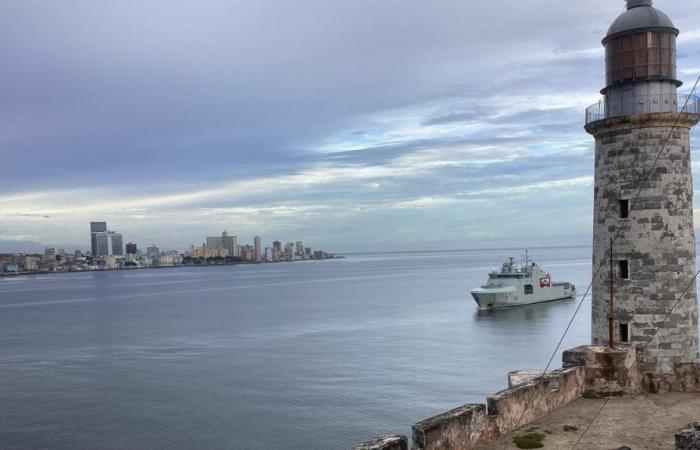The decision of Canada to send to the warship Margaret Brooke last week to the port of Havana to dock alongside the flotilla of Russian warships that arrived on the Island It was “a military mission”acknowledged this Monday, June 17, the Minister of Defense, Bill Blair.
“This was a direct result of a request made to me by the commander of the joint operations command and the admiral in charge of the Royal Canadian Navy,” Blair said, quoted by the Canadian network CBC.
“The port visit was carefully planned at the request of Canada and it was announced by the military in advance,” he added.
Blair also confirmed that the Margaret Brooke will return to Canadian waters on Monday, just after Moscow’s flotilla left the Island.
The minister said he was aware that Russian warships would be in Havana port when he gave authorization to the Navy to request permission from the Cuban regime to send the HMCS Margaret Brooke to its waters.
“The Canadian ship visited Havana to demonstrate Canada’s presence, naval capacity and commitment to safe and open waters in the Americas”, he pointed. “This was a military mission. They asked me for authorization to do it and I gave it to them,” she emphasized.
Blair indicated that the Canadian Army will continue to track the movements and activities of the Russian ships, whose next destination is unknown.
Canada is “committed to maintaining a credible military presence at sea and in the air around our continent,” Blair said.
“Any foreign actor that comes to our neighborhood can expect to see our Armed Forces fulfilling its mission to protect Canada’s interests,” he added.
Blair’s statements contrast with the official note from Havana. When announcing the arrival to the Island of the ship from the member country of the North Atlantic Treaty Organization (NATO), the Cuban Revolutionary War Navy He assured that “the visit (…) takes place in the context of the eightieth year of our uninterrupted diplomatic relations with that country and the fiftieth anniversary of cooperation ties.”
According to that statement, “the vessel belongs to a new series recently introduced into the Royal Canadian Navy, and “His visit to our country highlights bilateral collaboration to contribute to peace in our region.”
“The stay in Havana of this ship will take place before returning to its port of origin, in Halifax, and offers the opportunity to celebrate and reinforce the historic bilateral relationship between Cuba and Canada. It also provides continuity to the visits received in 2016 and 2018, by the frigates HMCS Fredericton and HMCS Charlottetown, respectively,” he concluded.
However, It was not clarified why the arrival of the Margaret Brooke to the Island coincided with the stay of the Kremlin flotillaas well as his departure with the departure of the Russian naval group.
Apart from the Ottawa ship deployed to Havana, last week the HMCS Ville de Québec, the US destroyer USS Truxton and the US Coast Guard ship USCGS Stone, among other warships, followed the flotilla of ships from Russian war as they crossed the Atlantic to the Caribbean.
Canada also deployed CP-140 patrol aircraft to monitor the flotilla as it moved up the east coast, Blair said.
During the voyage, the Russian ships carried out exercises using the new Zircon hypersonic missiles. Blair said that despite this, the Kremlin flotilla does not represent “an immediate threat” to Canada.
The US says it has no information on the direction of the Russian flotilla, but it monitors its movements
The United States reported this Monday, June 17, that it had no information about the course of the Russian flotilla, which left the port of Havana after just over five days of stay, but reiterated that it is closely monitoring it.
“We don’t have information on where it’s going, but it’s important to put it in perspective. The Russians do this every few years, they take an excursion to Caribbean and Latin American waters,” White House National Security Council spokesman John Kirby said in a press conference cited by EFE.
As DIARIO DE CUBA was able to verify, after the departure of the Russian naval assets to the open sea, the Boeing P8-A Poseidon, a submarine hunting aircraft of the US fleet, began operating off the coast of Havana. This medium was in the group mobilized last week to monitor the Russian flotilla as it sailed towards Cuba, skirting the Atlantic coast of the United States.
Likewise, this editorial team confirmed through satellite tracking sites that At least eight US Navy warships and patrol boats were north of Havana.
The North American attack submarine USS Helena also remains at the Guantánamo Naval Base since last week, after arriving at that destination the day after the deployment of the Russian flotilla in Havana.
The Russian agency Interfax reported, citing the press service of the Northern Fleet, to which the naval assets belong, that “after leaving the territorial waters of the Republic of Cuba, the detachment of ships will continue to carry out tasks in accordance with the plan long-distance campaign”.






